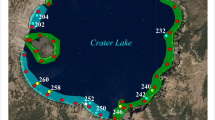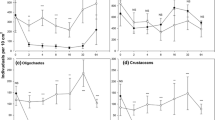Abstract
Large omnivorous predators may play particularly important roles determining the structure of communities because of their broad diets and simultaneous effects on multiple trophic levels. From June 2001 to June 2002 we quantified community structure and ecosystem attributes of six newly establishing freshwater ponds (660 m2 each) after populations of omnivorous crayfish (Orconectes virilis) were introduced to three of the ponds. Crayfish preyed heavily on fish eggs in this experiment, which reduced recruitment of young-of-year fish. This effect indirectly enhanced zooplankton biomass in crayfish ponds. Phytoplankton abundance exhibited a more complex pattern and was probably influenced by non-trophic (e.g., bioturbation) effects of crayfish. Peak dissolved oxygen levels were lower in the crayfish ponds indicating that they had lower primary production: respiration ratios. Metaphytic algae were strongly affected by crayfish presence; filamentous greens quickly disappeared and the blue-green Gleotrichia (a less preferred food item) eventually dominated the composition in crayfish ponds. Chara vulgaris and vascular macrophytes established 34% cover in control ponds by June 2002, but were not able to establish in crayfish ponds. Two important periphyton herbivores (tadpoles and gastropods) were absent or significantly reduced in the crayfish ponds, but periphyton differences were temporally variable and not easily explained by a simple trophic cascade (i.e., crayfish—snails and tadpoles—periphyton). Our results indicate that crayfish can have dramatic direct and indirect impacts on littoral pond communities via feeding links with multiple trophic levels (i.e., fish, invertebrates, and plants) and non-trophic activities (bioturbation). Although the effects of omnivorous crayfish on littoral communities can be large, their complex effects do not fit neatly into current theories about trophic interactions or freshwater community structure.




Similar content being viewed by others
References
Abrahamsson SAA (1966) Dynamics of an isolated population of the crayfish Astacus astacus. Oikos 17:96–107
Angeler DG, Sánchez-Carrillo, García G, Alvarez-Cobelas M (2001) The influence of Procambarus clarkii (Cambaridae, Decapoda) on water quality and sediment characteristics in a Spanish floodplain wetland. Hydrobiologia 464:89–98
Axelsson E, Nyström P, Sidenmark J, Brönmark C (1997) Crayfish predation on amphibian eggs and larvae. Amphibia-Reptilia 18:217–228
Black RW III, Hairston NG Jr (1988) Predator driven changes in community structure. Oecologia 77:468–479
Brooks JL, Dodson SI (1965) Predation, body size and the composition of the plankton. Science 150:28–35
Buck DH, Thoits CF III (1970) Dynamics of one-species population of fishes in ponds subject to cropping and additional stocking. Bull Ill Nat Hist Surv 30:69–165
Burns CW (1969) Relation between filtering rate, temperature, and body size in four species of Daphnia. Limnol Oceanogr 14:693–700
Carpenter SR, Kitchell JF (1993) The trophic cascade in lakes. Cambridge University Press, New York
Chambers PA, Hanson JM, Burke JM, Prepas EE (1990) The impact of the crayfish Orconectes virilis on aquatic macrophytes. Freshw Biol 24:81–91
Corey S (1987) Comparative fecundity of four species of crayfish in southwestern Ontario, Canada (Decapoda, Astacidae). Crustaceana 52:276–286
Collins NC, Harvey HH, Tierney AJ, Dunham DW (1983) Influence of predatory fish density on trapability of crayfish in Ontario lakes. Can J Fish Aquat Sci 40:1820–1828
Covich AP, Palmer MA, Crowl TA (1999) The role of benthic invertebrate species in freshwater ecosystems. BioScience 49:119–127
Creed RP (1994) Direct and indirect effects of crayfish grazing in a stream community. Ecology 75:2091–2103
Crowl TA, McDowell WH, Covich AP, Johnson SL (2001) Freshwater shrimp effects on detrital processing and nutrients in a tropical headwater stream. Ecology 82:775–783
Diehl S (1993) Relative consumer sizes and the strengths of direct and indirect interactions in omnivorous feeding relationships. Oikos 68:151-157
Dorn NJ, Mittelbach GG (1999) More than predator and prey: a review of interactions between fish and crayfish. Vie Milieu 49:229–237
Dumont HJ, Van de Velde I, Dumont S (1975) The dry weight estimate of biomass in a selection of cladocera, copepoda, and rotifera from the plankton, periphyton, and benthos of continental waters. Oecologia 19:75–97
Estes J, Smith NS, Palmisano JF (1978) Sea otter predation and community organization in the western Aleutian Islands, Alaska. Ecology 59:822–833
Feminella JW, Resh VH (1989) Submersed macrophytes and grazing crayfish: an experimental study of herbivory in a California freshwater marsh. Holarct Ecol 12:1–8
Flint RW, Goldman CR (1975) The effects of a benthic grazer on the primary productivity of the littoral zone of Lake Tahoe. Limnol Oceanogr 20:935–944
Gamradt SC, Kats LB (1996) Effect of introduced crayfish and mosquitofish on California newts. Conserv Biol 10:1155–1162
Gamradt SC, Kats LB, Anzalone CB (1997) Aggression by non-native crayfish deters breeding in California newts. Conserv Biol 11:793–796
Geddes P, Trexler JC (2003) Uncoupling of omnivore-mediated positive and negative effects on periphyton mats. Oecologia 136:585–595
Guan R, Wiles PR (1997) Ecological impact of introduced crayfish on benthic fishes in a British lowland river. Conserv Biol 11:641–647
Hobbs HH III (1993) Trophic relationships of North American freshwater crayfishes and shrimps. Milwaukee Public Mus Contrib Biol Geol 85:1–110
Howarth RW, Michaels AF (2002) The measurement of primary production in aquatic ecosystems. In Sala OE, Jackson RB, Mooney HA, Howarth RW (eds) Methods in ecosystem science. Springer, New York Berlin Heidelberg, pp 72–84
Karlsson-Elfgren I, Rengefors K, Gustafsson S (2004) Factors regulating recruitment from the sediment to the water column in the bloom-forming cyanobacterium Gleotrichia echinulata. Freshw Biol 49:265–273
Leibold MA (1996) A graphical model of keystone predators in food webs: trophic regulation of abundance, incidence, and diversity patterns in communities. Am Nat 147:784-812
Lodge DM, Hill AM (1994) Factors governing species composition, population size, and productivity of cool-water crayfishes. Nord J Freshw Res 69:111–136
Lodge DM, Kratz TK, Capelli GM (1986) Long-term dynamics of three crayfish species in Trout Lake, Wisconsin. Can J Fish Aquat Sci 44:591–597
Lodge DM, Kershner MW, Aloi JE, Covich AP (1994) Effects of an omnivorous crayfish (Orconectes rusticus) on a freshwater littoral food web. Ecology 75:1265–1281
Magnuson JJ, Capelli GM, Lorman JG, Stein RA (1975) Consideration of crayfish for macrophyte control. In: Brezonik PL, Fox JL (eds) The proceedings of a symposium on water quality management through biological control. Rep. No. ENV 07–75–1, University of Florida, Gainesville, FL, USA, pp 66–74.
Matthews M, Reynolds JD (1992) Ecological impact of crayfish plague in Ireland. Hydrobiologia 234:1–6
McPeek MA (1990) Determination of species composition in the Enallagma damselfly assemblages of permanent lakes. Ecology 71:83–98
Menge BA, Sutherland JP (1987) Community regulation: variation in disturbance, competition, and predation in relation to environmental stress and recruitment. Am Nat 130:730–757
Mittelbach GG, Turner AM, Hall DJ, Rettig JE, Osenberg CW (1995) Perturbation and resilience: a long-term, whole-lake study of predator extinction and reintroduction. Ecology 76:2347–2360
Momot WT (1995) Redefining the role of crayfish in aquatic ecosystems. Rev Fish Sci 3:33–63
Momot WT, Gowing H (1977) Production and population dynamics of the crayfish Orconectes virilis in three Michigan lakes. J Fish Res Board Can 34:2041–2055
Momot WT, Gowing H, Jones PD (1978) The dynamics of crayfish and their role in ecosystems. Am Midl Nat 99:10–35
Nyström P (1999) Ecological impacts of introduced and native crayfish on freshwater communities. In: Gherardi F, Holdich DM (eds) Crayfish in Europe as alien species. Balkema, Rotterdam, The Netherlands, pp 63–85
Nyström P, Åbjörnsson K (2000) Effects of fish chemical cues on the interactions between tadpoles and crayfish. Oikos 88:181–190
Nyström P, Strand JA (1996) Grazing by a native and an exotic crayfish on aquatic macrophytes. Freshw Biol 36:673–682
Nyström P, Brönmark C, Granéli W (1996) Patterns in benthic foodwebs: a role for omnivorous crayfish? Freshw Biol 36:631–646
Nyström P, Svensson O, Lardner B, Brönmark C, Granéli W (2001) The influence of multiple introduced predators on a littoral pond community. Ecology 84:1023–1039
Olsen TM, Lodge DM, Capelli GM, Houlihan RJ (1991) Mechanisms of impact of an introduced crayfish (Orconectes rusticus) on littoral congeners, snails, and macrophytes. Can J Fish Aquat Sci 48:1853–1861
Paine RT (1980) Food webs: linkage, interaction strength and community infrastructure. J Anim Ecol 49:667–685
Persson L (1999) Trophic cascades: abiding heterogeneity and the trophic-level concept at the end of the road. Oikos 85:385–397
Peterson CH, Renaud PE (1989) Analysis of feeding preference experiments. Oecologia 80:82–86
Polis GA, Strong DR (1996) Food web complexity and community dynamics. Am Nat 147:813–816
Power ME (1992) Habitat heterogeneity and the functional significance of fish in river food webs. Ecology 73:1675–1688
Pringle CM, Hamazaki, T (1998) The role of omnivory in a neotropical stream: separating diurnal and nocturnal effects. Ecology 79:269–280
Schaus MH, Vanni MJ (2000) Effects of gizzard shad on phytoplankton and nutrient dynamics: role of sediment feeding and fish size. Ecology 81:1701–1719
Stein RA (1977) Selective predation, optimal foraging, and the predator-prey interaction between fish and crayfish. Ecology 58:1237–1253
Stein RA, DeVries DR, Dettmers JM (1995) Food web regulation by a planktivore: exploring the generality of the trophic cascade hypothesis. Can J Fish Aquat Sci 52:2518–2526
Steiner CF (2002) Context-dependent effects of Daphnia pulex on pond ecosystem function: observational and experimental evidence. Oecologia 131:549–558
Stenroth P, Nyström P (2003) Exotic crayfish in a brown water stream: effects on juvenile trout, invertebrates and algae. Freshw Biol 48:466–475
Usio N, Townsend CR (2002) Functional significance of crayfish in stream food webs: roles of omnivory, substrate heterogeneity, and sex. Oikos 98:512–522
Vadas, RL Jr (1990) The importance of omnivory and predator regulation of prey in freshwater assemblages of North America. Environ Biol Fish 27:285–302
Wellborn GA, Skelly DK, Werner EE (1996) Mechanisms creating community structure across a freshwater habitat gradient. Annu Rev Ecol Syst 27:337-363
Welschmeyer NA (1994) Fluorometric analysis of chlorophyll a in the presence of chlorophyll b and pheopigments. Limnol Oceanogr 39:1985–1992
Acknowledgements
We are grateful to K. Gross, S. Hamilton, S. Kohler, D. Lodge, G. Mittelbach, A. Sarnelle, J. Trexler, H. Wojdak, and two anonymous reviewers for helpful comments and discussions on earlier drafts of the manuscript. T. Darcy generously provided algal identification and J. Gapzinski provided crayfish (Saline Fisheries Research ponds). An NSF site improvement grant DBI-9907740 to G. Mittelbach made the experiment and measurements possible. N.J.D. and J.M.W. received financial support from Graduate Research Training Fellowships funded through NSF grants DIR-09113598 and DBI-9602252 to KBS, and from G. H. Lauff Research Awards. This is KBS contribution number 1129.
Author information
Authors and Affiliations
Corresponding author
Rights and permissions
About this article
Cite this article
Dorn, N.J., Wojdak, J.M. The role of omnivorous crayfish in littoral communities. Oecologia 140, 150–159 (2004). https://doi.org/10.1007/s00442-004-1548-9
Received:
Accepted:
Published:
Issue Date:
DOI: https://doi.org/10.1007/s00442-004-1548-9




